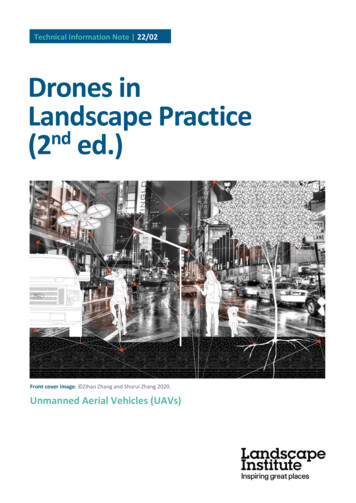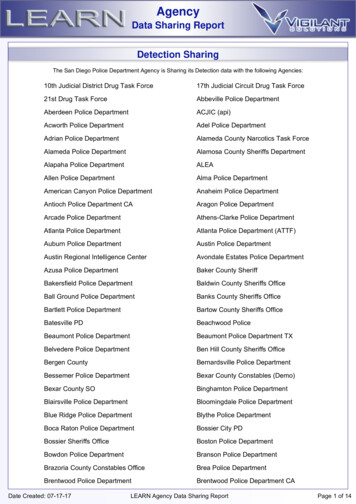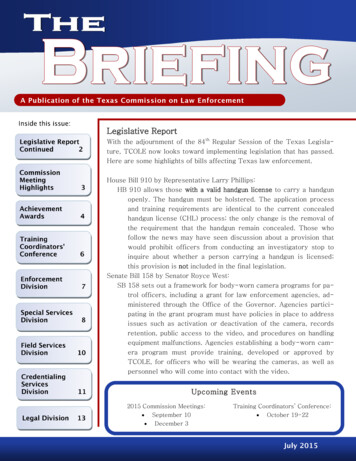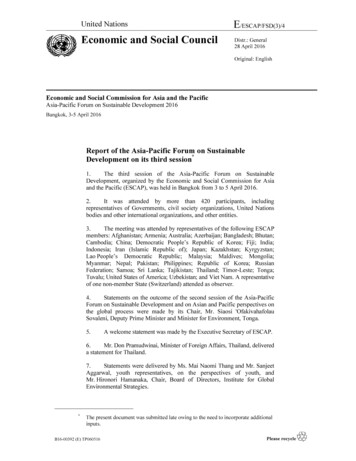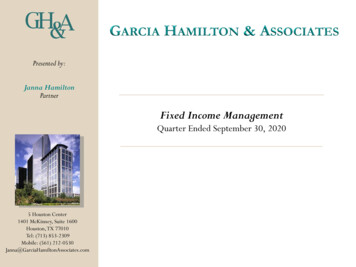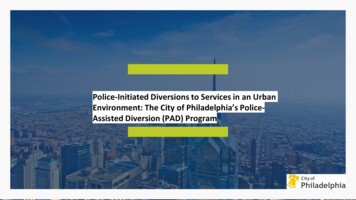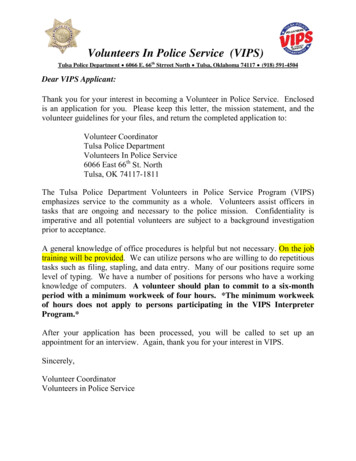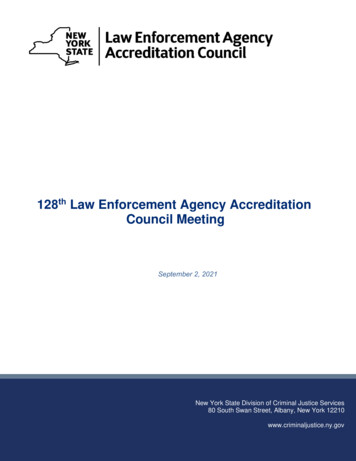
Transcription
D ro n e sand a Wake-Up Call about the Threat of Malicious Drone Attacks
This project was supported, in whole or in part, by cooperative agreement number 2016‐CK‐WX‐K009 awarded to PERF by the U.S. Departmentof Justice, Office of Community Oriented Policing Services. The opinions contained herein are those of the author(s) or contributor(s) and donot necessarily represent the official position or policies of the U.S. Department of Justice. References to specific individuals, agencies,companies, products, or services should not be considered an endorsement by the author(s), the contributor(s), or the U.S. Department ofJustice. Rather, the references are illustrations to supplement discussion of the issues.The internet references cited in this publication were valid as of the date of publication. Given that URLs and websites are in constant flux,neither the author(s), the contributor(s), nor the COPS Office can vouch for their current validity.This resource was developed under a federal award and may be subject to copyright. The U.S. Department of Justice reserves a royalty‐free,nonexclusive, and irrevocable license to reproduce, publish, or otherwise use and to authorize others to use this resource for FederalGovernment purposes. This resource may be freely distributed and used for noncommercial and educational purposes only.Recommended citation:Police Executive Research Forum. 2020. Drones: A Report on the Use of Drones by Public Safety Agencies—and a Wake‐Up Call about the Threatof Malicious Drone Attacks. Washington, DC: Office of Community Oriented Policing Services.Published 2020
ContentsLetter from the Director of the COPS Office . iiiLetter from the Executive Director of PERF . ivAcknowledgments. viExecutive Summary. viiOverview . viiThe research behind this report . viiiKey findings and recommended practices . viiiMalicious use of drones . xiiRisks in moving too slowly .xiiiIntroduction . 1State of the field and policy analysis . 1Addressing community concerns about privacy . 2Project overview . 2Methodology. 21. Pre-Implementation Considerations. 5Laws and regulations: Federal, state, and local . 6Community outreach . 11Selecting drone equipment. 19Funding considerations . 222. Establishing a Drone Program . 29Staffing your drone team . 29Drone team training. 31Standard operating procedures . 36
3. Malicious Use of Drones . 61Law, policy, and regulations limit law enforcement’s use of certain technologies to counterdrones . 61New federal law . 62New authority on remote identification is critical . 62New law provides little to no role for local police . 63The risks of moving too slowly. 64Educating Drone Hobbyists to Reduce the Number of Unauthorized Drones at Major Events . 74Recommendations for preventing and responding to the malicious use of drones . 78Conclusion. Local Law Enforcement Agencies are Learning to Use Drones; Now They Must Focus onStopping Malicious Drone Attacks. . 81Police use of drones . 81Malicious use of drones by terrorists and other criminals . 82Appendix A. Conference Participants . 85Appendix B. List of Agencies that Provided their UAS Standard Operating Procedures to PERF . 94Appendix C. Palm Beach County Sheriff’s Office Template for Writing Search Warrants for Using Drones. 95About PERF. 98About the COPS Office . 99iiDrones: A Report on the Use of Drones by Public Safety Agencies
Letter from the Directorof the COPS OfficeColleagues:Unmanned Aerial Systems (UAS) have rapidly changed the state of play in the public safety theater.Inappropriate use and deployment of UASs and their operators present a serious threat to public safetyand order. The same technology also offers tremendous opportunities to improve safety outcomes forour communities and for our sworn law enforcement practitioners and other public safety firstresponders. The COPS Office is committed to collecting, documenting, and disseminating the bestavailable information on UASs for state, local, tribal, and territorial (SLTT) law enforcement agencies.Last year, the COPS Office, the U.S. Department of Homeland Security (DHS), and the Police ExecutiveResearch Forum (PERF) convened a two-day conference for experts across the law enforcementcommunity on drones, their use and implementation, and attendant policy and operational issues.Representatives from several agencies presented on several topics: Regulations, community concerns, budgetary matters, and promising practices for setting upprograms for use of drones in law enforcement Recommendations for operating such a program, including training and staffing Counter-use matters, such as detection and disabling technology and dangerous illegal droneuse by bad actorsThis report summarizes the information discussed at that conference and also presents lessons learnedand promising practices gathered from interviews, policy reviews, and survey data. The presentationsand discussions from this event have informed all of our UAS work going forward, and we appreciate theongoing support and engagement from PERF, our colleagues at DHS, and all of the conferenceparticipants as we navigate this new frontier in law enforcement.We recognize that UASs present unique challenges both for our SLTT practitioners, and we are here forthe duration. The need for this report was driven by the field and the report itself is for the field. Wehope that you find it useful and that you will engage with us as we develop our resources for using andmanaging UASs.Sincerely,Phil KeithDirectorOffice of Community Oriented Policing Services
Letter from the Executive Directorof PERFColleagues:As I write this, the United States is in the midst of the COVID-19 pandemic, which is putting tremendousstrains on everyone, including police departments. Police leaders are working overtime to maintainservices and protect public safety, while also focusing on protecting their employees against infectionand managing staffing shortages. Other issues in policing are taking a back seat to the pandemic crisis.However, the topic of this report—police use of Unmanned Aircraft Systems, or drones—has relevanceeven during the COVID crisis. For example, drones are being used by the Elizabeth (NJ) PoliceDepartment to disperse crowds and enforce social distancing rules. 1 The Daytona Beach (FL) PoliceDepartment is using two drones equipped with loudspeakers to communicate with the public withoutgetting too close. 2 In the United Kingdom and across Europe, police are using drones to monitorpeople’s movements and enforce lockdown orders. 3 And in Israel, police are using drones to confirmthat those who tested positive for COVID-19 are self-isolating. 4When the COVID pandemic abates and conditions begin to return to normal, police agencies will turntheir focus to other issues of drones raised in this report. There are two separate aspects of this: (1) thepolicy and operational considerations of police agencies using drones to advance public safety, and (2)the need for police to have certain legal authority and technical capabilities for disabling drones whenthey present a threat to public safety.Drones are quickly becoming one of the most innovative and effective technologies used by policeagencies today. Yet, despite the exponential increase in the number of agencies using drones, there isstill a lack of clarity on how police should launch a drone program.Rebecca Panico, “Stop and Disperse! NJ City will Use Drones to Yell at People Not Social Distancing,” NJ.com, lastmodified April 7, 2020, t-social-distancing.html.1Patricio G. Balona, “Coronavirus: Daytona Police Using Drone with Loudspeaker to Limit Officers’ Contact withPeople,” Daytona Beach News-Journal, last modified April 7, 2020, zzie Darden, “Coronavirus: Police Use Drone to Shout Messages at People Telling Them to Go Home amid EasterCrackdown,” The Independent, last modified April 11, 2020, weekend-a9460401.html.3Joseph Krauss, “Israeli Police Use Drones to Check In on Virus Patients,” U.S. News and World Report, April 14,2020, irus-patients.4
To address these questions and produce policy guidance for law enforcement agencies, the PoliceExecutive Research Forum (PERF), with support from the U.S. Department of Justice’s Office ofCommunity Oriented Policing Services (COPS Office) and the U.S. Department of Homeland Security(DHS), held a two-day conference in February 2019 in Washington, D.C. This meeting featured morethan 200 police chiefs, sheriffs, officers, scholars, stakeholder groups, representatives from federalagencies, and other experts to discuss the policy and operational issues regarding the implementationand use of drones.On the first day of PERF’s conference, participants discussed what agencies need to consider beforestarting a drone program. For example, what laws and regulations must police agencies comply with?How should police interact with and involve the community before purchasing drones? What type ofdrones should police purchase, and what other equipment, such as cameras, should be attached to thedrone?On the second day of PERF’s conference, participants addressed a more urgent issue—how federal,state, and local law enforcement agencies must respond to the malicious use of drones – i.e., when theyare used in a manner that threatens public safety. Although there is technology available to counterthreatening drones, local police agencies do not have the legal authority to use it, because accidentalmisuse could cause as much damage as a hostile drone. Despite these legal limitations, the publicexpects that local police agencies will respond and protect and protect the community if a dronethreatens public safety.This report documents the promising practices and lessons discussed by the conference participants.The recommendations in this report will help police agencies that are interested in implementing adrone program, and will provide guidance on how to respond when a drone threatens the safety of thecommunity.Sincerely,Chuck WexlerExecutive DirectorPolice Executive Research ForumDrones: A Report on the Use of Drones by Public Safety Agenciesv
AcknowledgmentsPERF would like to thank the U.S. Department of Justice’s Office of Community Oriented PolicingServices (COPS Office) and the U.S. Department of Homeland Security’s (DHS) Office for State and LocalLaw Enforcement (OSLLE) for supporting this research into drones. We are grateful to COPS OfficeDirector Phil Keith and Deputy Director Rob Chapman and to OSLLE Deputy Assistant Secretary BrianDorow for recognizing the increasingly important role that this technology plays in advancing the workof law enforcement agencies and other first responders. At the same time, the COPS Office and OSLLErecognize the other critical issue addressed in this report: the severe threat to public safety whenterrorists or other criminals use drones as weapons. Director Keith has been an outspoken advocate ofdrone programs and getting ahead of the serious threat of malicious use of drones. And we want toespecially thank Brendan Groves, Senior Counsel to the Deputy Attorney General, who provided hisinvaluable expertise on the legal authorities in this area. We are also grateful for the support andguidance provided by our program manager at the COPS Office, Helene Bushwick.We would also like to thank the law enforcement agencies that participated in our survey on drones.Their thoughtful responses guided our research and agenda for a two-day conference in Washington,D.C., in February 2019. We are grateful to the more than 200 police chiefs, sheriffs, scholars, and otherprofessionals who participated in our conference (see appendix A for a list of participants). Theseleaders provided valuable information about their experiences with drones and provided an insightfultwo-day discussion of the benefits of drones, as well as the new threats this technology has created.Thanks also go to the more than 50 police executives and department personnel who shared their dronepolicies with PERF and participated in interviews with PERF staff. Their candid assessments of how thistechnology has impacted their agencies shaped the findings in the publication.Finally, credit is due to PERF staff members who conducted the survey, prepared for and hosted theconference, conducted interviews, and helped write and edit this publication, especially Director ofTechnical Assistance Jessica Toliver; Director of Communications Craig Fischer; Assistant Director ofCommunications James McGinty; Senior Research Associates Lisa Mantel and Dave McClure; SeniorResearch Assistant Adam Kemerer; Research Assistants Hyla Jacobson and Adam Kass; and ResearchInterns Tatiana Lloyd-Dotta and Shira Moolten.
Executive SummaryOverviewThis report is about two opposite but related issues: (1) the use of drones by police agencies to protectpublic safety and (2) the use of drones by malicious actors to commit various crimes such as acts ofterrorism. Thus, the story of drones is about two radically different sides of the same coin.This report actually should be seen as two separate reports.The bulk of the document, chapters 1 and 2, provides guidance to police and sheriffs’ departmentsabout how to identify the ways in which drones could facilitate their work and how to create a droneprogram to accomplish those goals.The remainder of the document, chapter 3, is about the malicious use of drones. As of early 2020, theUnited States is extremely vulnerable to drone attacks because only in late 2018 were federal lawenforcement agencies given the legal authority to use the most effective types of technologies to detectand mitigate drone threats. Local police and sheriffs’ departments still are unable to purchase or usemost counter-drone technologies because of concerns they might break the law when employing themand the danger of interference with air traffic in the National Airspace System.This is not merely oversight by Congress and federal agencies; there are important reasons for limitingdrone detection and mitigation technologies. Careless or unskilled use of these technologies could resultin disaster. For example, technologies that use radio signals to jam an incoming malicious drone or seizecontrol of it, improperly used, might interfere with radio signals used by commercial or private airplanesor air traffic controllers.A number of federal and local law enforcement agencies have begun to explore counter-dronestrategies at major events and mass gatherings such as the Super Bowl. But this work is still developing.Federal, state, and local lawmakers and government officials, including law enforcement officials, shouldaccelerate their efforts to address these issues as soon as possible.The drone strikes against oil facilities in Saudi Arabia in September 2019, which temporarily disruptedapproximately half of that kingdom’s oil production capacity, demonstrate how much harm can be doneby the malicious use of drones. The United States must not wait until it suffers a drone attack toundertake large-scale efforts to develop strategies by law enforcement agencies at all levels ofgovernment for (1) identifying drone threats and (2) mitigating drone threats in real time.
The research behind this reportIn 2018 and 2019, the Police Executive Research Forum (PERF), with support from the U.S. Departmentof Justice’s (DOJ) Office of Community Oriented Policing Services and the U.S. Department of HomelandSecurity’s (DHS) Office for State and Local Law Enforcement, conducted research, disseminated a surveyof law enforcement agencies, and hosted a two-day forum to discuss police use of drones and the policeresponse to the threat of drones being used maliciously.This project consisted of three major components: (1) an informal survey of 860 law enforcementagencies nationwide; (2) interviews with more than 50 police executives and personnel in agencies thatoperate a drone program or have plans to implement one; and (3) a two-day national conference inwhich police executives, federal stakeholders, and other experts from across the country discussed anddebated the considerations associated with police use of drones. The purpose of this report is to assistpolice agencies interested in establishing their own drone programs. 5Key findings and recommended practicesThis report is divided into three chapters:1. Pre-Implementation Considerations2. Establishing a Drone Program3. Malicious Use of DronesFollowing are some of the key findings and recommendations detailed in this report.Pre-implementation considerationsThe use of drones, or unmanned aircraft systems (UAS), 6 in the policing profession has been on the risesince approximately 2016 as drones have become more readily available. Law enforcement agencieswho have deployed drones say there are many benefits associated with using these devices. They notethat drones are useful for search and rescue missions, disaster response, crowd monitoring, trafficcollision reconstruction, crime scene reconstruction, and investigating armed and dangerous suspects.However, many community members have legitimate concerns about the use of drones by anyone,including the police, because of the privacy issues that occur when small, lightweight devices with videoThis report is intended to document the results of the February 2019 conference and to disseminate and shareinformation across the state, local, tribal, and territorial law enforcement community. It does not create any legalrights or obligations and has no legally binding effect. This report may not be used for the purpose of coercingpersons or entities outside of the Federal Government into taking any action or refraining from any action.5The U.S. Department of Defense and the Federal Aviation Administration use the term unmanned aircraft system(UAS), as do aviation and air traffic organizations worldwide, to emphasize the importance of more than just thecrewless aerial vehicle—that is, the software, ground control stations, data links, etc. This report will use the termUAS interchangeably with the more colloquial drone but will not use UAV, RPAV, or other less comprehensiveterms.6viiiDrones: A Report on the Use of Drones by Public Safety Agencies
cameras can fly almost anywhere. Thus, some considerations for police agencies interested in usingdrones to advance public safety include undertaking a methodical process of explaining their planspublicly; holding public meetings and other forums in which community members can express theirconcerns; and working with the community to reach acceptable compromises or consensus approachesto issues such as defining the purposes of police drones, managing the use and possible storage of videoor other data obtained by drones, and addressing the public’s legitimate concerns and questions.Prior to implementing a drone program, state and local agencies must consider a number of factors thatwill impact the operations of their program, including federal, state, and local laws and regulations;conducting community outreach; selecting drone equipment; and funding the drone program.Federal, state, and local laws and regulations Research all federal, state, and local laws and regulations that will dictate your agency’s droneuse before starting your program. Work with your agency’s legal team to ensure drone teammembers understand the laws and regulations they must follow. Consider obtaining both a part 91 certificate of authorization and a part 107 license from theFederal Aviation Administration (FAA) to conduct your program’s drone operations formaximum use and flexibility. In states and municipalities with restrictive legislation, reach out to fellow agencies in the areato learn how the limitations affect their operations. Prepare templates for search warrants facilitated by the use of drones and applications forwaivers of certain limitations that sometimes affect drone operations (an example warranttemplate is included from one jurisdiction in appendix C to this report).Community outreach Engage with the community before implementing a drone program to ensure support for theprogram. Proactively reach out to community organizations that are likely to have reservations aboutdrone use, such as civil liberties or privacy interest groups, prior to programimplementation. This can help the agency to get ahead of concerns, address them properly,and avoid misunderstandings. Solicit feedback from community stakeholders to ensure that community concerns areaddressed properly. Host outreach events during a variety of days and times to ensure that a large majority ofcommunity members will be able to attend such events.Drones: A Report on the Use of Drones by Public Safety Agenciesix
Communicate with the public and community stakeholders about the authorized and officialpurposes of your drone program to ease privacy concerns about uses of drones and alleviateconcerns about unauthorized uses or purposes. Stress that the use of drones is to promote public safety and not for loosely definedsurveillance purposes. Use print, broadcast, and social media to inform and engage the public. Involve your agency’s public information officer to share information widely.Be transparent about your agency’s drone policies and practices both prior to and afterimplementation. For example: Posting your drone policy on the department’s website andreleasing video of successful drone deployments (when footage can be made public) canreassure the community about your purpose and intent.Selecting drone equipment Decide on the goals and purposes of your drone program and establish the operationalparameters and specifications of features and capabilities you need to inform your purchase ofdrone equipment. Regardless of your specific drone model needs, start small, use inexpensive models first, andtest your equipment prior to program implementation. Implement your drone program on a trial basis with a set time for a formal evaluation process.This process allows flexibility to make changes to the scope of services and equipment neededfor your program before final implementation. Take incremental steps as you develop your program to allow time to solicit communityfeedback and adjust as necessary. Funding will naturally affect any agency’s decision-making. Some drones and their associatedtechnology are expensive in addition to the personnel hours and IT support that each programrequires.Funding and outfitting a drone programx In budgeting for a drone program, consider the initial equipment costs as well as the long-termtraining, maintenance, and upgrade costs that come with maintaining drones. Engage the community in supporting drone use to help secure funding for your program. Conduct a cost-benefit analysis to demonstrate cost savings associated with drone use. Dronescan be far more cost-effective than helicopters in performing certain functions. Look into potential grants or community partnerships to help offset program costs.Drones: A Report on the Use of Drones by Public Safety Agencies
Establishing a drone programStaffing your drone team Create the drone team roles based on your agency’s individual needs and any state or localregulations or requirements. Consider training drone pilots from different units to ensure that expertise will be available forresponse to any type of incident, e.g., accident reconstruction, special weapons and tactics(SWAT), or missing persons. Determine how many drone pilots should be certified based upon the size of your jurisdiction aswell as the incident types that the drone team will be responsible for responding to. Use both sworn and nonsworn personnel to reduce costs and maximize expertise.Drone team training Require drone training for all agency personnel who will be assisting with drone procedures toensure operational proficiency. Include the following topics if developing your own training protocols: Methods of conducting safe flight operations under exigent circumstances Crew Resource Management and a risk assessment-based model for decisions aboutwhether to accept or decline a UAS flight request Missions and fleet management Operational guidelines for UAS pilots and technicians within an agency An understanding of the role the FAA plays in public safety regulatory compliance Rules of evidence related to UAS operations and agency requirements How to present UAS-collected data in court to further justice Methods to ensure compliance with Constitutional protections regarding free speech,privacy, and civil liberties Purchase inexpensive drones for new pilots to practice with during initial training. Train visual observers in different units (such as bomb squad or accident reconstructionpersonnel) to ensure someone arrives on scene in a timely manner. Set ongoing training requirements so team members remain proficient in drone operations andup to date on FAA rules and regulations.Drones: A Report on the Use of Drones by Public Safety Agenciesxi
Malicious use of dronesAll law enforcement agencies, whether or not they wish to begin a program for using drones for theirown purposes, must consider a related but far more difficult challenge: how to anticipate, prevent,detect, and respond to the criminal use of drones, including use by terrorists. For example, terroristscould use drones to drop a bomb or spray a poisonous gas over large crowds of people at a public event.Drones also can be extremely effective at reconnaissance for criminal purposes because they can flypast
The research behind this report Key findings and recommended practices viii Malicious use of drones Risks in moving too slowly xiii Introduction State of the field and policy analysis 1 Addressing community concerns about privacy Project overview 2 Methodology 2 1. Pre-Implementation Considerations 5 Laws and regulations: Federal, state, and local

